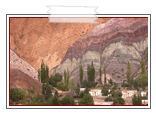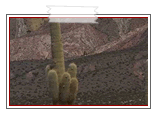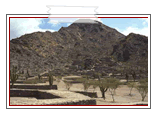![]()
Northern provinces feature traces of pre-Columbian cultures, mingled with ruins of natives’ villages, as well as forts and constructions dating back to the time of the Conquest and Colonization.
Time seems to stand still in the high plateau of the Puna, a land full of mountain ranges, steep mountain paths, and gorges. Villages have been built in the small valleys. Multi-coloured and monochromatic hills covered with huge cactuses on the slopes surround the villages.

Esta región permite el encuentro con un paisaje pleno de contrastes, desde las altas cumbres hasta la llanura, con salares y selvas subtropicales, en el que echó sus raíces la cultura latinoamericana.
Province of Jujuy
Area: 53.219 Km²
Population: 611,888 inhabitants
Density: 11,5 inhabitants per Km²
Capital: San Salvador de Jujuy
Distances
from
Buenos Aires: San Salvador de Jujuy : 1.643 Km
San Miguel de Tucumán: 1.310 Km
Salta: 1.605 Km
PLACES TO VISIT:
SAN SALVADOR DE JUJUY. Capital of the Province. In the main square stands the Cabildo (Town Council), the Cathedral, and the Casa de Gobierno (Government House). The chapel of Santa Bárbara, with tiled roof, is the oldest church in town. .
QUEBRADA DE HUMAHUACA. Vividly coloured landscapes frame a group of villages where time seems to stand still. One of the most beautiful villages is Purmamarca, an indigenous village lying against the Seven-colour Mountain, which strata illustrates various geological ages. One of the most outstanding attractions in this ravine is the Pucará de Tilcara, a fortified town built by the Omaguaca natives in pre-Columbian times.

THE PUNA. The ancient Inca road with its impressive salt pans. La Quiaca is one of the most important towns in this extensive area. 50,000 birds inhabit the Laguna de los Pozuelos Natural Monument, the largest water reserve in the Puna.
THE CITY OF SALTA : Its name comes from the Aymará word "sagta", which means "the very beautiful one". This city has the best preserved colonial architecture in the country. Its most significant buildings surround the main square: the Cathedral, the Cabildo or Town Council which houses the North Historical Museum. The church of San Francisco has one of the highest church towers in America (53 m)
"TRAIN TO THE CLOUDS" This 219 Km long railway starts at the provincial capital and crosses the giant iron viaduct La Polvorilla, which is 4,182 m above sea level. It also crosses the Valle de Lerma and goes through the Quebrada del Toro, getting as high as the Puna.
CALCHAQUIES VALLEYS: Beautiful landscapes, colourful mountains, and historical villages like Cafayate, San Carlos, Angastaco, Molinos and Cachi. This is a land of good wines and constant sun.

NATIONAL PARKS: El Rey and Baritú - Both parks are in mountainous areas and have a wide variety of subtropical flora and fauna.
SAN MIGUEL DE TUCUMÁN, CAPITAL OF THE PROVINCE. It is the commercial, cultural, and industrial center of the Argentine northwest. Some of its remarkable buildings are the Historic House of Independence, where the Independence Act was signed in 1816.
QUILMES RUINS: At the Menhires Park, there are 130 amazing pieces of granite carved by the ancient Quilmes aboriginals. To this date little is known about their culture, only that this was an old fortress built in their time by these ingenuous aboriginal inhabitants of the region.